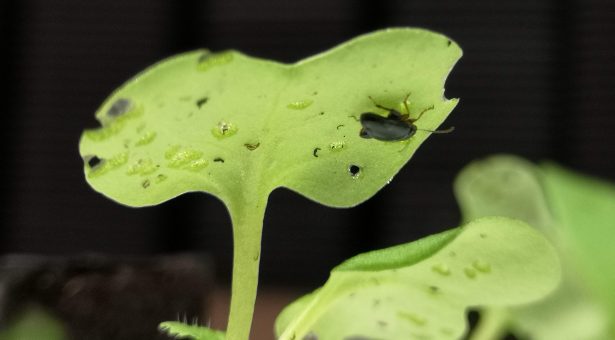Oilseed Rape and the Cabbage Stem Flea Beetle

Oilseed rape crops are worth £700m+ to the UK economy each year but are increasingly vulnerable to the devastating Cabbage Stem Flea Beetle (CSFB).
We asked PhD student Lucy Thursfield, who is working on CSFB in collaboration with Limagrain UK and the French company Innolea to explain what the problem is and how we are working towards a solution.
What is the Cabbage Stem Flea Beetle?
The Cabbage Stem Flea Beetle (CSFB) is a little, iridescent, black beetle. It isn’t related to fleas, but gets its name from having large, powerful femurs, which allow it to leap like a flea.
CSFB feeds on cruciferous vegetables, which most people will know as “leafy greens”, so things like broccoli, cabbage and cauliflower.
It sounds harmless, what is the problem?
As well as those “leafy greens, the CSFB also enjoys a spot of oil seed rape, which means that at this time of year CSFB hit the headlines for all the wrong reasons. They have a year-long lifecycle, during which the larvae enter the plants, where they eat the entire inside of the stem, before emerging to eat all the leaves on the outside, which as you can imagine, is pretty devastating to the crop.
This is a problem because while we don’t eat oil seed rape, is a vital component of UK agriculture.
It is used to generate rapeseed oil and generates around £768m for the UK economy. Crucially, oil seed rape is also a key rotation crop, which farmers grow to refresh the soil and keep pests of other major crops down. This means that if oil seed rape losses are so high, that farmers abandon it as a crop, it could lead to shortages in other crops, such as wheat. The husks of oil seed rape are also very high in protein and are used for lots of animal feed.
In 2018 neo-nicotinoids, a type of pesticide that were systemic and as such would cover the entire crop, were banned. This meant our last line of defence against CSFB was pyretheroids, which you spray across a field. Unfortunately, these only cover the outside of a crop so don’t do anything to prevent the larvae which are already inside the crop from doing the damage. Resistance is also now being seen to pyretheroids, so farmers have few options to control the damage.
Mild winters don’t help the situation. When it is cold, CSFB don’t lay eggs, but because the last few winters have been relatively mild, they have been laying all through spring, meaning there are now thousands of young beetles emerging in fields, where they just move through the crop like locusts.
It’s estimated that CSFB accounts for between 5-15% of the crop being lost, or around £70m per year, so this is a problem that needs attention.
What can we do to solve the problem?
There are a number of potential solutions.
One of these is genetically modifying crops to be less appealing to the CSFB, but growing GM crops remains banned in the EU and UK, so we need an alternative solution.
Short-term we can look at integrated pest control management which could be to encourage natural predators, change the way the soil is tilled or growing a trap crop, which the CSFB would prefer to eat even more than oil seed rape. This entices the CSFB to the sacrificial crop, in-turn protecting the oil seed rape. However, to do this farmers would need to sacrifice large areas of their fields for the trap crop, which costs them time and money, so there is resistance to this approach.
Some would like to see new pesticides developed, but there is a growing desire to move away from pesticides and we know that they become less effective over time as pests develop resistance to them.
Because of this we are working on developing genetic resistance through plant breeding.
To do this we look at lots and lots of cruciferous vegetables to see which ones CSFB prefer to eat or avoid. When we know which ones they dislike, we can identify why they avoid them. Is it the taste or smell, or is it something else. Once we know that, we can figure out the genetic sequence that confers that trait, which we can then look to introduce to oil seed rape.
We are currently researching potential genes of interest. However, this is a time-consuming process, but in the lab we have the benefit of using GM techniques to identify a trait and then transform a plant to have that and then test if that gene does what we’d like it to. Even with this advantage we would then need to breed any beneficial traits into crops the traditional way so we are a number of years away from having anything that can be used in the field.
Lucy is supported by the UKRI Biotechnology and Biological Sciences Research Council Norwich Research Park Biosciences Doctoral Training Partnership by a CASE Award in collaboration with Innolea and Limagrain UK.



